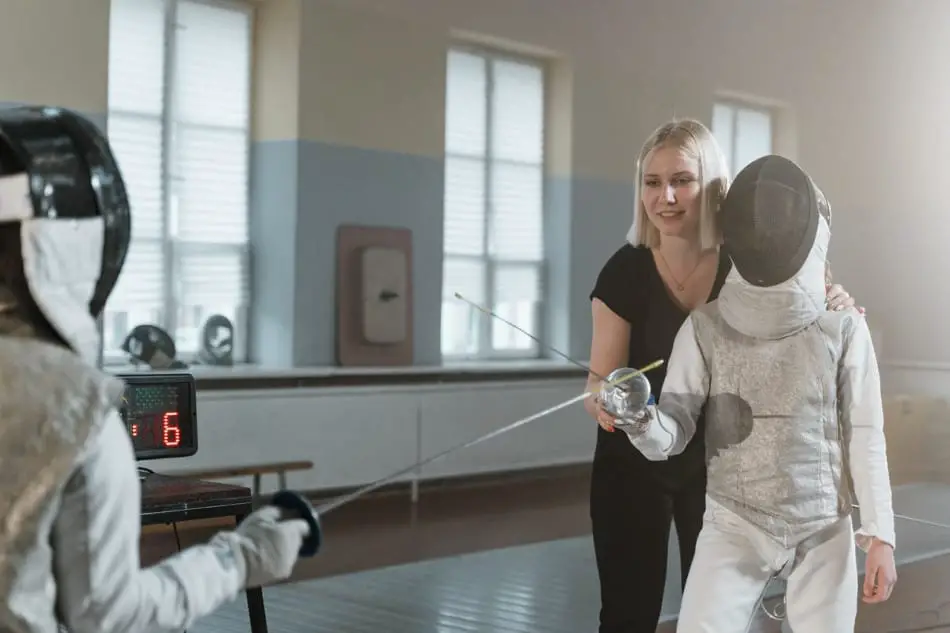Fencing has always been a comprehensive body sport that requires strength, stamina, coordination, speed, and agility. This combat sport involves two players competing against one another.
However, it doesn’t necessarily mean you can’t practice or learn fencing by yourself just because you don’t have a partner.
So, is fencing something you can actually learn by yourself?
Yes, you can learn the technical skills of fencing by yourself. Technical skills such as various movements, tactics, footwork, body alignment, basic distance, cutting drills, and accuracy. These are some of the vital elements that a swordsman should master – and all these can be learned online. Through various videos on YouTube for those who learn visually, or blog articles for a more theoretical, in depth approach.
Although fencing is a group activity, this guide will help you find ways to excel without a partner.
You will learn the various ways to practice fencing by yourself as much as possible, and why this sport is the right choice for you.
So, tighten your seatbelt, and let’s start.
5 Steps to Learning Fencing By Yourself:

Now that you know that you can learn fencing all by yourself, here are the simple steps to doing so:
Step 1: DIY Drills
You can start with the sharpening of skills like footwork, sword control, and lunging with a regular schedule of DIY drills and exercises.
Make sure that your practice drills are exciting to make your solo practice seem interesting while improving your game.
Step 2: Lunges
Go in front of a mirror and start practicing lunges. Being one of the most significant foundation movements, practicing lunging motion will help you with a great kick start to learning fencing.
All you have to do is move into a lunge position in front of a mirror.
Why the mirror? Because it will help you notice any problems with the form. Hold the foil and fend off towards the mirror to recheck the form. Take a note on things like posture or form where you could make improvements.
With the help of a lunging drill, you’ll learn how to recoup from a shove or knocked-off position to an awakened and vigilant position.
If you excel at lunges, you’ll know how to recover and feel light during an actual fencing match quickly.
-> Read Also What Is An Autodidact?
Step 3: Practice Fencing By Yourself

Now, you can take a tennis ball and hang it from the ceiling while ensuring the ball is at your chest level.
Take a broomstick or a sword, whatever you have, and practice sword control.
Try to attempt the thrust towards the tennis ball and practice hitting it only with the tip of the broomstick or sword.
However, this may seem like an arduous task as the target (ball) size is small.
The interesting fact is that the smaller the object, the better you learn.
If you don’t find it to be difficult enough, you can alter the tennis ball with an even smaller object like a golf ball. Then, repeat the same process.
Every time you contact the ball, try to stop it from swinging.
Keep practicing sword control on your own by positioning the sword/stick’s length away from the small object or a doorknob and outlining a circle around the shape.
Step 4: Learning Offensive and Defensive Positions
Now, you’ll have to learn and practice the footwork for fencing. Start by creating drill combinations that involve numerous offensive returns and defensive positions at once.
It’s advisable to perform every sequence for at least two minutes. You can take a rest of one minute in between every sequence.
Begin with the advance, on-guard, or advance-lunge sequence while focusing on the form and the balanced lunges that you sharpened in front of the mirror.
Next, you can try and practice to jump redouble, forward-lunge, or on-guard.
Remember that no matter what the sequence is, you’ll always have to return to your on-guard position.
Step 5: Minimize Recoil
Sharpen and improve your repulse or block by decreasing your capability to recoil.
You can’t step backward, and to make that a habit, position some block behind your back foot during practice.
Then, proceed to practice a wholly offensive sequence where you won’t be able to recoil or fall back.
Without any chances to move back, you’ll be forced and driven to consider sequences that you may not have thought of before.
It’s an ideal way to get better at offensive movements in fencing.
-> Learn More about Self-Learning vs. Classroom Learning: Which Is Better?
Fencing Techniques You Can Learn By Yourself

If you like the idea of fencing and really indulge in it but have never had any contact or practice session before, it’s unlikely for you to learn the sport completely by yourself.
If you have never fenced before, the chances are that you’ll leave the crucial details in techniques and movements unnoticed.
A few things like understanding the right movements, timing of execution, and feet and arm coordination are vital to this sport that cannot be self-taught. These are something that learners decide to pick up.
Although it can be challenging to learn how to fence, it’s possible to learn the sport alone. The actions during a fencing session are based on considerable speculation about this sport.
These actions can be known and excelled at by anyone who is willing to put their time and effort into it.
However, if you want to learn fencing to be a referee, you must develop and ace the technical skills as well.
But watching sessions and reading instructions can be a great start.
Considering that you’ll learn fencing for your zest and passion for the sport, here’s a table for beginners that contains all the important terminologies about fencing skills that they need to know.
| Fencing terminologies | Definition |
| Retreat | Footwork movement that requires you to move backward |
| Advance | Fencing movement that requires you to move forward |
| Lunge | Attacking movement that requires you to make an explosive movement forward |
| Parry | A defensive movement that requires you to block the attacks with the blade |
| Disengagement | Offensive action that requires you to move the blade to avoid any parry |
| Counterattack | You are required to do this during the opponent’s attack to score. |
Equipment Needed To Learn Fencing By Yourself

Fencing is a combat sport that requires several pieces of equipment. From weapons and masks for personal use to a scoring machine and a piste for general use, you need a lot of things to practice fencing with a partner.
However, when it comes to practicing fencing by yourself, a broomstick or some iron stick or rod can effectively do the job.
Although practicing the sport in such a manner would be difficult, it’s the best alternative if you’re not willing to buy all the fencing equipment as they’re a bit costly.
The good news is that you’ll need a good pair of athletic shoes, breathable shirts and shorts, and the willingness to learn the sport dedicatedly by yourself.
Assuming that you have the money to spare for the equipment to learn fencing by yourself, there is a table that can help you take a look at all the equipment you need along with their prices and features.
| Fencing Equipment | Product Examples | Price (subject to change) | Feature(s) |
| Fencing Shoes | ROPHOO Fencing Shoes for Men & Women | $109 | Durable, breathable, and comfortable cushioning |
| Fencing Blades | DSI Excalibur Color Guard Saber 36″ | $134.95 | Lifetime warranty, strong and durable |
| Fencing Chest Guard | LEONARK FIE Certificate Fencing Sport Chest Guards | $42.99 | Complies to FIE competition standards |
| Fencing Mask | ThreeWOT Fencing Mask | $75.49 | Light, breathable, comfortable |
| Fencing Uniform | ThreeWOT 350NW Fencing Uniform Suit | $119.99 – $129.99 | CE Certified with Level 1 protection |
Frequently Asked Questions
1. Is fencing too difficult to learn?
No, fencing is not difficult to learn if you practice regularly and follow professionals’ best advice, suggestions, and training tactics.
With proper practice, good form, and valuable insight into the techniques and skills, you can quickly learn fencing and make progress.
2. Am I too old to learn fencing?
You’re never too old to learn any sport. You can learn fencing at any age. Several fencers in the world have started to learn this combat sport after the age of 18.
However, the best-recommended age to start learning to fence is seven.
3. Can I get in good shape by practicing fencing?
Yes, fencing will help you get in good shape as it ensures several physical benefits to the body.
It enables you to boost your cardiovascular endurance, strength, flexibility, balance, agility, and coordination.
Although fencing is a complete body sport, it helps to improve the thighs, arms, buttocks, and hips the most.
It also helps you enhance mental agility.
4. Can I learn fencing without using a blade?
Yes, you can learn fencing without using a blade. You can either choose a shadow fence or a broomstick to get started with this sport.
It will help you get started with skills like footwork.
-> Learn more about the 7 best websites for self-learning
Final Thoughts
Fencing is a combat sport that is often compared to chess. Both require attention, focus, proper analysis of the actions, and an in-depth understanding of the techniques and skills involved in the game.
You can choose to do all those by yourself to learn to fence and become a pro at it. Your willingness and dedication should be your first step toward learning fencing by yourself.
We hope this guide will be the perfect resource for you.
So, best of luck!






